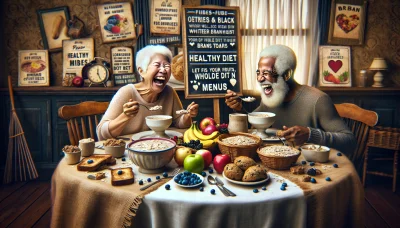High-fiber foods for toddlers constipation Quiz
Test Your Knowledge
Question of
Understanding Toddler Constipation
Causes of Constipation in Toddlers
Dietary Factors
The foods a toddler consumes play a critical role in their digestive health. A diet lacking in fiber-rich fruits, vegetables, and whole grains can lead to constipation. Excessive dairy intake and reliance on processed foods may also contribute to irregular bowel movements.
It's imperative to introduce a variety of fiber-packed foods into a toddler's diet. This not only aids digestion but also establishes healthy eating habits early on. Parents should monitor their child's fiber intake daily to ensure it meets the recommended levels for their age.
Hydration Levels
Inadequate fluid intake is a common culprit behind constipation in toddlers. Water is essential for softening stool and promoting its movement through the intestines. A lack of sufficient hydration can result in hard stools that are difficult to pass.
Encouraging toddlers to drink water throughout the day is crucial. Offer water regularly, especially in hot weather or when your child is more active. Consider setting a routine for water breaks to instill healthy hydration habits.
Physical Activity
Physical activity stimulates bowel movements by increasing blood flow and intestinal contractions. A sedentary lifestyle can slow down these processes, leading to constipation. Toddlers need regular physical activity to maintain bowel regularity.
Making time for play and movement is essential. Whether it's structured sports, free play, or family walks, active engagement helps keep your toddler's digestive system running smoothly.
Recognizing the Signs and Symptoms
Changes in Bowel Movements
A noticeable change in the frequency, consistency, or ease of bowel movements is often the first sign of constipation. Stools may become infrequent, hard, dry, or difficult to pass. Parents should track these changes as they are key indicators of constipation.
Maintaining a diary or chart of your toddlers bowel movements can be helpful in identifying patterns and disturbances in their routine. Such records provide valuable information for healthcare providers if intervention becomes necessary.
Behavioral Indicators
Toddlers may not always verbalize their discomfort but may exhibit behavioral changes instead. Avoidance of bathroom visits or expressing fear related to defecation can be signs of constipation-related discomfort or pain.
Watch for signs such as reluctance to use the toilet, hiding during bowel movements, or holding postures like crossing legs or clenching buttocks. These behaviors suggest that its time to take action and address potential constipation issues.
Physical Discomfort
- Belly Pain: Your child may complain about pain or cramping in the belly area due to backed-up stool.
- Bloating: Look out for a swollen belly or complaints of feeling full even without eating much.
- Pain During Bowel Movements: If your toddler expresses pain while trying to pass stool, this indicates that the stool is too hard and dry.
- Blood on Stool Surface: Hard stools can cause tiny tears around the anus leading to traces of bloodthis warrants immediate medical attention.
- Lack of Appetite: Constipation can make a toddler feel less inclined to eat due to the discomfort and bloating it causes.
The Role of Fiber in Toddler Diets
Types of Dietary Fiber
Dietary fiber is a powerhouse nutrient that plays a critical role in the overall health of toddlers. It's found in many plant-based foods and comes in various forms, each with unique benefits. Understanding these types can help parents make informed choices about their toddler's diet.
Soluble Fiber dissolves in water to form a gel-like substance, aiding digestion and helping to lower cholesterol and blood glucose levels. It's found in oats, apples, carrots, and beansfoods that are both nutritious and toddler-friendly.
On the flip side, Insoluble Fiber doesn't dissolve in water. It adds bulk to the stool and can help food pass more quickly through the stomach and intestines. Whole grains, nuts, and vegetables like cauliflower or green beans are excellent sources.
Lets not forget about Prebiotic Fiber , which acts as food for beneficial gut bacteria. This type of fiber contributes to a healthy gut microbiome, essential for digestion and immunity. Foods like bananas, onions, and garlic are great prebiotic options.
Daily Fiber Requirements for Toddlers
When it comes to daily fiber intake for toddlers, precision is key! The requirements vary with age because as children grow, so do their nutritional needs. Parents should aim for an intake that supports their child's digestive health without causing discomfort.
For toddlers aged 1-3 years old, the American Academy of Pediatrics recommends a daily fiber intake roughly equivalent to their age plus 5 grams. This means a 2-year-old should have about 7 grams of fiber per day. Its all about balance!
Incremental increases in dietary fiber can help avoid any potential digestive issues such as bloating or constipation. Gradually adding high-fiber foods into a toddler's diet allows their system to adjust smoothly.
- Start Slow: Introduce fiber-rich foods one at a time.
- Stay Hydrated: Ensure ample fluid intake as fiber intake increases.
- Variety Matters: Offer different types of fiber-rich foods to provide a range of nutrients.
- Be Creative: Incorporate fibers in fun ways like smoothies or whole-grain pancakes.
- Monitor Stools: Keep an eye on your childs bowel movements to gauge tolerance.
- Beware of Excess: Too much fiber can lead to discomfort or reduced nutrient absorption.
Monitoring for tolerance is crucial when upping fiber intake in toddlers' diets. Every child is unique and may respond differently to dietary changes. Parents should watch out for signs of too much fiber such as diarrhea or abdominal pain and adjust accordingly.
High-Fiber Foods for Toddlers
Fruits Rich in Fiber
Fruits are a tasty way to increase your toddler's fiber intake. They're packed with vitamins and minerals, and their natural sweetness is a hit with the little ones. Introducing a variety of fruits into your toddler's diet can help maintain healthy digestion and prevent constipation.
Pears and Apples are fantastic fiber-rich choices. The skins of these fruits contain insoluble fiber, which aids in digestion. Serve them as slices or baked for a warm treat. Remember, keeping the skin on maximizes the fiber content!
Berries and Bananas not only add vibrant colors to your child's plate but are also a reliable source of fiber. Berries like strawberries, raspberries, and blueberries can be mixed into yogurts or cereals, while bananas work brilliantly as a portable snack.
Prunes and Plums are often hailed as natural remedies for constipation due to their high fiber content. Prune juice or pureed plums can be particularly effective in promoting regular bowel movements in toddlers.
Vegetables That Help Relieve Constipation
Vegetables are not only essential for a balanced diet but also provide the necessary dietary fiber to combat constipation. Encouraging toddlers to eat a variety of vegetables can help keep their digestive systems running smoothly.
Leafy Greens , such as spinach and kale, are loaded with fiber. These greens can be incorporated into smoothies or omelets to make them more appealing to toddlers who might otherwise be reluctant to eat them.
- Broccoli and Carrots: These veggies are not only high in fiber but also full of nutrients that support overall health. Serve them steamed with a dip or shredded into meals for easier consumption.
- Sweet Potatoes and Squash: With their creamy texture and sweet taste, they're often well-accepted by toddlers. They can be mashed, roasted, or even turned into fun shapes to entice little ones.
- Tips for Introducing High-Fiber Veggies:
- Start with small portions to gradually introduce new flavors.
- Mix vegetables with favorite foods to make them more palatable.
- Create fun shapes or use colorful plates to make mealtime exciting.
- Praise your child when they try new vegetables to encourage positive eating habits.
Creating a Balanced High-Fiber Menu
Sample High-Fiber Meal Plans
Embarking on a high-fiber diet can transform your health, with benefits ranging from improved digestion to reduced risk of chronic diseases. Crafting a high-fiber meal plan requires incorporating a variety of fiber-rich foods across all meals. Let's dive into some delicious and nutritious ways to kickstart your day, keep you energized through lunch, and wind down with a satisfying dinner.
Breakfast Ideas: Start your day with a bang! Oatmeal topped with berries provides a hearty dose of fiber while keeping it naturally sweet. For those on-the-go mornings, consider whole-grain toast smeared with avocado - it's not only trendy but also packs in the fiber and healthy fats!
Lunch Suggestions: Keep that midday slump at bay with fiber-filled lunches. A quinoa salad adorned with an array of colorful veggies offers a crunch and nutrient boost. Alternatively, a lentil soup can be both comforting and filling, ensuring you're ready to tackle the afternoon.
Dinner Options: Seal the deal with dinners that satisfy without compromising on fiber content. A stir-fry featuring brown rice or barley as the base, mixed with fibrous vegetables like broccoli and carrots, can be both comforting and healthful. Or go for baked sweet potatoes stuffed with beans and greens for a flavor-packed fiber punch!
Snacks and Treats with Fiber
Snacking smart is crucial for maintaining energy levels and meeting your daily fiber goals. Opting for homemade snacks gives you control over ingredients and ensures you're getting quality nutrition without unnecessary additives.
Homemade Snack Bars: Create your own snack bars using oats, nuts, seeds, and dried fruit they're portable and customizable to your taste preferences. Not only do they offer convenience, but they also deliver a substantial amount of fiber in every bite!
- Fruit and Veggie Smoothies: Blend kale or spinach with your favorite fruits for a smoothie that's bursting with fiber and vitality. Perfect for an after-workout boost or an afternoon pick-me-up!
- Whole Grain Crackers and Cheese: Pair whole grain crackers with a slice of cheese for an indulgent yet fiber-rich snack. The combination of complex carbs and protein will keep hunger pangs at bay.
Tips for High-Fiber Snacking:
- Mix different types of fruits and veggies in smoothies to maximize nutrient intake.
- Bake snack bars in batches so you always have them on hand when hunger strikes.
- Choose whole grain options whenever possible they generally contain more fiber than refined versions.
- Incorporate nuts or seeds into snacks for added protein, healthy fats, and extra fiber.
- Avoid processed snacks that claim to be "high in fiber" but are loaded with sugars or artificial ingredients.
Hydration and Its Impact on Digestion
Importance of Fluids in Digestive Health
Hydration plays a pivotal role in maintaining optimal digestive health. It facilitates the breakdown of food, enabling nutrients to be more easily absorbed by the body. Without adequate fluids, digestion becomes sluggish, leading to potential discomfort.
Drinking enough water aids in dissolving fats and soluble fiber, preventing digestive issues like constipation. By ensuring smooth transit within the intestines, hydration is key to avoiding gastrointestinal distress.
Water Consumption Guidelines
It's crucial to adhere to specific water consumption guidelines to maintain digestive well-being. Experts recommend drinking at least eight 8-ounce glasses of water per day, which equates to about 2 liters or half a gallon.
This amount varies depending on individual activity levels, climate, and overall health. Paying attention to your body's signals, like the color of your urine, can be an excellent indicator of hydration status.
Effects of Dehydration on Bowel Movements
Dehydration can have a significant impact on bowel movements. It often leads to constipation as the colon absorbs more water from waste, making stools harder and more difficult to pass.
To prevent this uncomfortable condition, it is essential to consume enough fluids throughout the day. This simple practice not only improves bowel regularity but also supports overall digestive health.
Encouraging Toddlers to Drink More Water
Toddlers are notoriously picky about their beverage choices, often preferring sugary drinks over water. However, instilling good hydration habits early is vital for their long-term health.
- Lead by Example: Children mimic adults. Drink plenty of water yourself and make it a shared activity.
- Fun Containers: Use colorful cups or bottles with their favorite characters to make drinking water more exciting.
- Add Flavor: Introduce slices of fruits to subtly flavor the water without adding sugar.
- Routine: Establish regular water breaks throughout the day so that it becomes a part of their routine.
- Educate: Teach them about the benefits of drinking water through stories or games.
- Reward System: Create a reward system for meeting daily water intake goals.
- Avoid Sugary Alternatives: Limit access to sugary drinks so that when they're thirsty, they reach for water instead.
Healthy Drinks for Toddlers
Besides water, there are other healthy beverages you can offer toddlers. These drinks should provide nutrients without excessive sugars or artificial additives.
Fruit Infused Water Recipes
Fruit-infused waters are fantastic alternatives that make hydration fun without compromising health. Combining slices of oranges, strawberries or cucumbers with water creates a refreshing taste toddlers love.
Herbal Teas for Kids
Certain herbal teas are safe for kids and can be a soothing beverage before bed. Opt for caffeine-free options like chamomile or peppermint which can also aid digestion.
Milk and Its Alternatives
Milk is a traditional staple in many children's diets; however, plant-based alternatives like almond or soy milk are gaining popularity. These options can offer variety while still providing essential nutrients needed for growth and development.
Integrating Fiber into a Toddler's Diet Gradually
Starting with Small Portions
When introducing fiber to a toddler's diet, begin with small, manageable amounts. This gradual approach helps their digestive system adjust without overwhelming it. Starting with portions that are too large can lead to discomfort and aversion, which we want to avoid at all costs!
Introducing New Foods Slowly
Add new high-fiber foods one at a time over several days or even weeks. This slow process allows you to monitor your child's reaction to each new food and ensures they're not overloaded with too many dietary changes at once. Remember, patience is key to successful dietary transitions!
Adjusting to Textures and Flavors
Toddlers can be picky eaters, especially when it comes to textures and flavors. Introduce fibrous foods with mild flavors and soft textures before moving on to the more complex ones. This strategy helps toddlers get used to the idea of fiber-rich foods as being just another part of their meals.
Monitoring for Gas or Bloating
As you introduce more fiber into your toddler's diet, keep a close eye on any signs of gas or bloating. These can be common side effects as their bodies learn to process increased fiber intake. If these symptoms occur, take a step back and reduce the portion size, then gradually build up again.
Combining High-Fiber Foods with Favorites
Mixing high-fiber foods with your toddlers favorite dishes can make them more palatable. It's like sneaking in health benefits without the battle! For example, adding pureed vegetables into spaghetti sauce boosts fiber while keeping the meal familiar and enjoyable.
Pairing with Familiar Tastes
To ensure that your little one is receptive to trying new, fiber-rich foods, combine them with well-liked flavors. This could mean topping a whole-grain cereal with slices of banana or blending veggies into a beloved smoothie recipe.
Making Fun and Appealing Presentations
Creativity goes a long way! Cutting fruits and vegetables into fun shapes or arranging them into colorful patterns can entice toddlers to try something new. The goal is to make the dining experience exciting so that fiber-rich foods are welcomed rather than rejected.
- Mix it up: Combine different types of fiber-rich foods to keep meals interesting.
- Pacing is crucial: Don't rush the process; give your child's system time to adapt.
- Beware of choking hazards: Ensure fibrous foods are cooked until soft enough for your toddler's chewing abilities.
- Educate through eating: Talk about the benefits of these healthy choices as they enjoy them.
- Stay hydrated: Increased fiber needs more fluids, so encourage regular water intake.
- Maintain balance: While fiber is important, ensure it doesn't overshadow other essential nutrients in their diet.
- Avoid additives: Opt for natural sources of fiber over those fortified with synthetic fibers.
- Keep it regular: Consistency in offering high-fiber options helps establish good habits.
- Note reactions: Watch out for any adverse reactions and adjust as necessary.
- Foster independence: Allow toddlers to pick from high-fiber options as they learn about healthy eating choices.
Using Dips and Spreads
Dips and spreads can be fabulous allies in introducing fiber-rich foods. A tasty hummus or yogurt dip might just be the ticket for getting those raw veggies off the plate and into your toddlers tummy!
Addressing Picky Eating Challenges
Strategies for Picky Eaters
Tackling picky eating begins with patience and creativity. It's crucial to introduce new foods slowly and in a non-pressuring way. Consistency is key, as repeated exposure can gradually reduce reluctance. Remember, the goal is to make mealtime a positive experience, not a battleground.
A great strategy to combat pickiness is to involve children in meal preparation. Giving them age-appropriate tasks, such as washing vegetables or stirring ingredients, fosters a sense of ownership and curiosity about the foods they're helping to create. This involvement can translate into greater willingness to try new dishes.
Involving Toddlers in Meal Prep
When toddlers take part in meal prep, their natural curiosity leads them to taste and explore new flavors. By giving them simple tasks like tearing lettuce or adding toppings, they feel empowered and more interested in eating what they've made. Plus, it's a fun way to bond and teach valuable life skills!
Offering a Variety of Choices
Providing a range of healthy options empowers picky eaters to make choices within set boundaries. This approach respects their preferences while subtly pushing the envelope towards broader food acceptance. It's all about balance and making sure there are always one or two familiar items on their plate.
Establishing a Routine
Creating a consistent eating schedule sets clear expectations for children. Regular meal and snack times help regulate hunger cues and reduce anxiety around eating. A structured routine also helps parents plan ahead, ensuring that meals are balanced and stress-free.
Nutrient-Dense Alternatives for Selective Eaters
For selective eaters, it's important to maximize the nutritional value of foods they do enjoy. Integrating nutrient-dense alternatives into familiar meals ensures that even limited diets are as nourishing as possible. This can be achieved through fortified foods or by sneaking healthy ingredients into beloved recipes.
Fortified Foods
Fortified foods are an excellent tool for boosting nutrient intake without altering favorite meals too much. From cereals enriched with vitamins to milk alternatives laced with calcium and vitamin D, these products help fill dietary gaps seamlessly. Always check labels to ensure these items fit into your overall nutrition plan.
Blending into Favorite Dishes
- Pureeing vegetables: Incorporate pureed veggies into sauces or batters for an unnoticeable health kick.
- Sneaky smoothies: Blend fruits with leafy greens for tasty drinks that look fun but pack a nutritional punch.
- Protein-packed pancakes: Add greek yogurt or protein powder into pancake mix for an extra boost.
- Nut butter blends: Mix nut butters with porridge or spread on whole-grain toast for healthy fats and protein.
- Cheese it up: Use cheese to top vegetables or stir into whole-grain pasta dishes; most kids love cheese!
- Fruit dips: Create yogurt-based dips for fruit slices to make snacking fun and nutritious.
Creative Food Shapes and Colors
Intriguing shapes and vibrant colors can make food more appealing to children. Using cookie cutters for sandwiches or making rainbow fruit skewers encourages kids to eat with their eyes first. The novelty of the presentation often overcomes resistance based on flavor alone.
Monitoring Progress and Adjusting Diets Accordingly
Keeping a Food and Symptom Diary
Maintaining a food and symptom diary is a game-changer for identifying foods that may be causing adverse reactions. This systematic approach allows for patterns to emerge, linking specific dietary choices to symptoms. It's crucial not only to track what is consumed but also the quantities and the times of consumption.
By analyzing this diary, you can pinpoint foods that may contribute to discomfort or allergic reactions. This proactive step empowers you to make informed adjustments to your diet, enhancing your overall well-being. It's a simple yet profoundly effective tool that puts you in control of your dietary health.
Tracking Fiber Intake
Fiber intake is critical for digestive health, and tracking it can optimize bowel functionality. A balanced fiber intake helps prevent both constipation and diarrhea, contributing to a well-regulated digestive system. Ensuring a variety of fiber sources from fruits, vegetables, and whole grains is key.
It's not just about quantity; the type of fiber matters too. Soluble fiber dissolves in water and can ease bowel movements, while insoluble fiber adds bulk to stool. Striking the right balance between the two types is essential for maintaining digestive harmony.
Noting Bowel Movement Patterns
Regular monitoring of bowel movement patterns provides invaluable insight into gut health. Changes in frequency, consistency, or ease of bowel movements can be early indicators of dietary imbalances or other health issues. This information is critical when discussing symptoms with healthcare professionals.
Bowel movement irregularities often signal the need for dietary adjustments. For instance, increasing water and fiber intake can alleviate constipation, while reducing high-fat foods might help with diarrhea management. This kind of vigilance ensures swift action towards maintaining digestive health.
Observing Behavioral Changes
Dietary changes can have profound effects on behavior and mood. Monitoring these shifts is essential as they can indicate whether dietary interventions are successful or if further modifications are needed. Increased energy levels or improved concentration can signify positive progress.
Conversely, irritability or lethargy after eating certain foods could suggest negative reactions or intolerances. By staying alert to these behavioral cues, you can fine-tune your diet for optimal mental and emotional well-being alongside physical health.
When to Consult a Pediatrician
- Persistent Constipation Issues: If constipation doesn't improve with dietary adjustments, it's time to seek medical advice. Chronic constipation could be symptomatic of underlying health concerns that require professional evaluation.
- Concerns About Growth and Development: If there are any red flags regarding your child's growth or development milestones related to their diet, don't hesitateconsult a pediatrician promptly.
- Dietary Supplement Considerations: Before introducing any supplements into your child's diet, consulting with a pediatrician ensures safety and appropriateness based on individual nutritional needs.
If you're grappling with persistent constipation issues despite tweaking the diet, it's time to call in the experts! A pediatrician will help rule out any serious conditions and provide targeted treatment options. They're your go-to resource when home remedies just don't cut it anymore.
Growth and development are paramount concerns for any parent. If you're worried that your child isn't hitting those key milestones or suspect their diet might be at fault, see a pediatrician without delay! Their expertise will guide you toward ensuring your child's optimal development.
Sometimes, our little ones need an extra nutritional boost through supplements. But before you embark on this route, consult with a pediatrician! They'll give you the green light if its beneficial or advise against it if unnecessarykeeping your child's health top priority!












